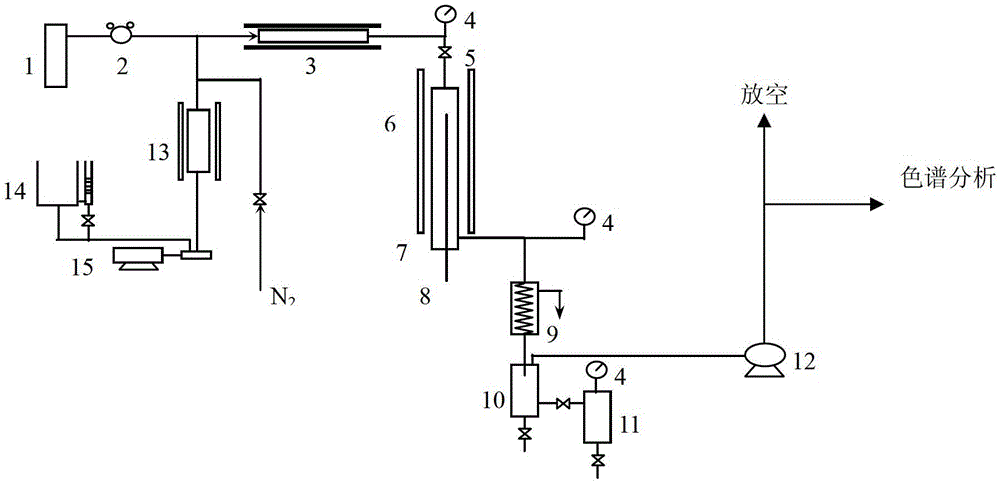Low-cost sulfur-tolerant shift catalyst and its preparation method
A sulfur-resistant shift and catalyst technology, which is applied in chemical instruments and methods, physical/chemical process catalysts, metal/metal oxide/metal hydroxide catalysts, etc. In order to achieve the effect of good structure and activity stability, simple process and reduced preparation cost
- Summary
- Abstract
- Description
- Claims
- Application Information
AI Technical Summary
Problems solved by technology
Method used
Image
Examples
Embodiment 1
[0038] The attapulgite clay was first calcined at 800°C for 2 hours, and then crushed through a 160-mesh sieve.
[0039] Dissolve 1.23g of ammonium molybdate in 40.0ml of deionized water to obtain solution A containing molybdenum; dissolve 1.94g of cobalt nitrate in 30.0ml of deionized water, then add 2.87g of manganese nitrate and 6.00g of citric acid into the above solution , stirring and dissolving to obtain solution B containing cobalt, manganese and binder.
[0040] Weigh 97.50g of the treated attapulgite clay and 8.00g of safflower powder and mix evenly, add solution A to the mixture, knead evenly; then add solution B, knead evenly and shape, dry naturally, at 500°C Calcined for 5 hours to obtain the finished sulfur-tolerant shift catalyst C-1. Its strength, pore structure and activity data are shown in Table 1 and Table 2.
Embodiment 2
[0042] The attapulgite clay was first calcined at 760°C for 2.5 hours, and then crushed through a 160-mesh sieve.
[0043] Dissolve 2.08g ammonium molybdate with 40.0ml deionized water to obtain solution A containing molybdenum; dissolve 2.33g cobalt nitrate with 30.0ml deionized water, then add 4.02g manganese nitrate and 4.00g citric acid to the above solution respectively , stirring and dissolving to obtain solution B containing cobalt, manganese and binder.
[0044] Weigh 96.30g of treated attapulgite clay and 4.0g of starch and mix evenly, add solution A to the mixture, knead evenly; then add solution B, knead evenly, shape, dry naturally, and roast at 530°C for 3.5h , to obtain the finished sulfur-tolerant shift catalyst C-2. Its strength, pore structure and activity data are shown in Table 1 and Table 2.
Embodiment 3
[0046] The attapulgite clay was first calcined at 740°C for 3.5 hours, and then crushed through a 160-mesh sieve.
[0047] Dissolve 2.33g of ammonium molybdate in 40.0ml of deionized water to obtain solution A containing molybdenum; dissolve 3.11g of cobalt nitrate in 30.0ml of deionized water, then add 4.60g of manganese nitrate and 3.00g of citric acid into the above solution , stirring and dissolving to obtain solution B containing cobalt, manganese and binder.
[0048] Weigh 95.70g of treated attapulgite clay and 3.00g of starch and mix evenly, add solution A, knead evenly; then add solution B, knead evenly, shape, dry naturally, and roast at 550°C for 2.5h to obtain the finished sulfur resistant Change Catalyst C-3. Its strength, pore structure and activity data are shown in Table 1 and Table 2.
PUM
| Property | Measurement | Unit |
|---|---|---|
| specific surface area | aaaaa | aaaaa |
| strength | aaaaa | aaaaa |
| specific surface area | aaaaa | aaaaa |
Abstract
Description
Claims
Application Information
 Login to View More
Login to View More - R&D
- Intellectual Property
- Life Sciences
- Materials
- Tech Scout
- Unparalleled Data Quality
- Higher Quality Content
- 60% Fewer Hallucinations
Browse by: Latest US Patents, China's latest patents, Technical Efficacy Thesaurus, Application Domain, Technology Topic, Popular Technical Reports.
© 2025 PatSnap. All rights reserved.Legal|Privacy policy|Modern Slavery Act Transparency Statement|Sitemap|About US| Contact US: help@patsnap.com



